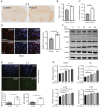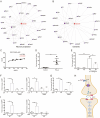IL-6 Enhances the Activation of PI3K-AKT/mTOR-GSK-3β by Upregulating GRPR in Hippocampal Neurons of Autistic Mice
- PMID: 38536552
- PMCID: PMC10972920
- DOI: 10.1007/s11481-024-10111-3
IL-6 Enhances the Activation of PI3K-AKT/mTOR-GSK-3β by Upregulating GRPR in Hippocampal Neurons of Autistic Mice
Abstract
Autism spectrum disorder (ASD) is a neurological disorder associated with brain inflammation. The underlying mechanisms could be attributed to the activation of PI3K signaling in the inflamed brain of ASD. Multiple studies highlight the role of GRPR in regulating ASD like abnormal behavior and enhancing the PI3K signaling. However, the molecular mechanism by which GRPR regulates PI3K signaling in neurons of individuals with ASD is still unclear. In this study, we utilized a maternal immune activation model to investigate the effects of GRPR on PI3K signaling in the inflamed brain of ASD mice. We used HT22 cells with and without GRPR to examine the impact of GRP-GRPR on the PI3K-AKT pathway with IL-6 treatment. We analyzed a dataset of hippocampus samples from ASD mice to identify hub genes. Our results demonstrated increased expression of IL-6, GRPR, and PI3K-AKT signaling in the hippocampus of ASD mice. Additionally, we observed increased GRPR expression and PI3K-AKT/mTOR activation in HT22 cells after IL-6 treatment, but decreased expression in HT22 cells with GRPR knockdown. NetworkAnalyst identified GSK-3β as the most crucial gene in the PI3K-AKT/mTOR pathway in the hippocampus of ASD. Furthermore, we found that IL-6 upregulated the expression of GSK-3β in HT22 cells by upregulating GRP-GRPR. Our findings suggest that IL-6 can enhance the activation of PI3K-AKT/mTOR-GSK-3β in hippocampal neurons of ASD mice by upregulating GRPR.
Keywords: Autism; GRPR; Hippocampus; IL-6; PI3K.
© 2024. The Author(s).
Conflict of interest statement
The authors declare that they have no competing interests.
Figures






Similar articles
-
Involvement of PI3K/Akt/GSK-3β and mTOR in the antidepressant-like effect of atorvastatin in mice.J Psychiatr Res. 2016 Nov;82:50-7. doi: 10.1016/j.jpsychires.2016.07.004. Epub 2016 Jul 7. J Psychiatr Res. 2016. PMID: 27468164
-
SEP-363856 exerts neuroprotection through the PI3K/AKT/GSK-3β signaling pathway in a dual-hit neurodevelopmental model of schizophrenia-like mice.Drug Dev Res. 2024 Jun;85(4):e22225. doi: 10.1002/ddr.22225. Drug Dev Res. 2024. PMID: 38879781
-
Neuroprotective effect of salidroside on hippocampal neurons in diabetic mice via PI3K/Akt/GSK-3β signaling pathway.Psychopharmacology (Berl). 2023 Sep;240(9):1865-1876. doi: 10.1007/s00213-023-06373-z. Epub 2023 Jul 25. Psychopharmacology (Berl). 2023. PMID: 37490132
-
mTOR Signaling Disruption and Its Association with the Development of Autism Spectrum Disorder.Molecules. 2023 Feb 16;28(4):1889. doi: 10.3390/molecules28041889. Molecules. 2023. PMID: 36838876 Free PMC article. Review.
-
Targeting PI3K-AKT/mTOR signaling in the prevention of autism.Neurochem Int. 2021 Jul;147:105067. doi: 10.1016/j.neuint.2021.105067. Epub 2021 May 13. Neurochem Int. 2021. PMID: 33992742 Review.
Cited by
-
Dysregulation of the mTOR-FMRP pathway and synaptic plasticity in an environmental model of ASD.Mol Psychiatry. 2025 May;30(5):1937-1951. doi: 10.1038/s41380-024-02805-0. Epub 2024 Nov 27. Mol Psychiatry. 2025. PMID: 39604505 Free PMC article.
-
Oxidative stress response and NRF2 signaling pathway in autism spectrum disorder.Redox Biol. 2025 Jun;83:103661. doi: 10.1016/j.redox.2025.103661. Epub 2025 May 2. Redox Biol. 2025. PMID: 40324316 Free PMC article. Review.
-
Astrocyte-mediated inflammatory responses in traumatic brain injury: mechanisms and potential interventions.Front Immunol. 2025 May 8;16:1584577. doi: 10.3389/fimmu.2025.1584577. eCollection 2025. Front Immunol. 2025. PMID: 40406119 Free PMC article. Review.
-
BDNF and GSK-3beta expression changes underlie the beneficial effects of crocin on behavioral alterations in a rat model of autism induced by prenatal valproic acid administration.Naunyn Schmiedebergs Arch Pharmacol. 2025 Jun;398(6):7571-7582. doi: 10.1007/s00210-024-03777-2. Epub 2025 Jan 8. Naunyn Schmiedebergs Arch Pharmacol. 2025. PMID: 39777538
-
Molecular targets and mechanisms of Sijunzi decoction in the treatment of Parkinson's disease: evidence from network pharmacology, molecular docking, molecular dynamics simulation, and experimental validation.Front Pharmacol. 2024 Nov 26;15:1487474. doi: 10.3389/fphar.2024.1487474. eCollection 2024. Front Pharmacol. 2024. PMID: 39660000 Free PMC article.
References
-
- Ahmed S, Abir AH, Sharmin O et al (2023) Modulation of PI3K/Akt/GSK3β signaling cascade through G protein-coupled receptor 55 (GPR55) activation: prenatal lysophosphatidylinositol attenuates valproic acid-induced synaptic abnormalities and mitochondrial dysfunction. Life Sci 334:122195 - PubMed
-
- Bagcioglu E, Solmaz V, Erbas O et al (2023) Modafinil improves autism-like behavior in rats by reducing neuroinflammation. J Neuroimmune Pharmacol 18(1–2):9–23 - PubMed
-
- Battle DE (2013) Diagnostic and statistical manual of mental disorders (DSM). Codas 25(2):191–192 - PubMed
-
- Bilanges B, Posor Y, Vanhaesebroeck B (2019) PI3K isoforms in cell signalling and vesicle trafficking. Nat Rev Mol Cell Biol 20(9):515–534 - PubMed
MeSH terms
Substances
Grants and funding
LinkOut - more resources
Full Text Sources
Medical
Molecular Biology Databases
Research Materials
Miscellaneous

